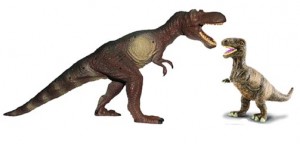Aves – The “Peter Pans” of the Dinosauria
New Study Suggests Birds are Dinosaurs that Never “Grew Up”
A new research paper, published in the scientific journal “Nature” suggests that modern birds (Neornithines) are essentially dinosaurs; as their skulls resemble the skulls found of juvenile dinosaurs in the fossil record. Descendants resembling the juveniles of their ancestors is not unknown amongst vertebrates, this process, known as paedomorphosis has been identified as having an involvement in a number of evolutionary transitions amongst animals with back-bones.
Birds are Dinosaurs
Birds, (Aves) are very closely related to the dinosaurs. Birds are the closest living relatives of the Order known as the Dinosauria and in this new study by Harvard scientists, the development of large brain size and the huge variety in beaks which has led to such a radiation in bird species has been traced back to paedomorphic tendencies that led to adult birds having similar shaped heads as their reptilian ancestors – theropod dinosaurs.
One of the two fundamental aspects of paedomorphosis is the acceleration of sexual maturity relative to the rest of an organism’s development. This is termed progenesis and in the Northern Hemisphere spring, right now, thousands of bird species are proving this point by raising young that rapidly grow up. Some modern birds can reach sexual maturation in under three months, thus our feathered friends are able to retain the features of a juvenile dinosaur into their adulthood.
The Cenozoic may be regarded as the “Age of Mammals” due to the large amount of Mammalian mega-fauna found in eco-systems but there are more species of birds on our planet today than species of mammals, thousands more. The success of the Aves, it could be argued could be related to their rapid development from a hatchling to a mature bird. To put it another way, birds grow up so fast that they retain in their adult forms the skull characteristics of the Dinosaurian ancestors – they are akin to the “Peter Pans” of the archosaurs, as one commentator put it.
The “Peter Pans” of the Archosauria
Bhart-Anjan Bhullar, Fernando Racimo and other colleagues from Harvard University, in conjunction with other scientific institutions including palaeontologists from the American Museum of Natural History (New York), compared three dimensional images of skulls of extant and extinct birds with fossilised skulls of dinosaurs. The team discovered that compared to their dinosaurian ancestors, the faces of birds became flattened and the brain cavity grew larger. A larger brain cavity was a pre-requisite for developing a bigger brain enabling birds to exploit a variety of ecological niches. In short, the skulls of Neornithines resemble those of baby dinosaurs.
Skull Morphology in Birds – Gives Hint of Dinosaurian Ancestry
Picture credit: Everything Dinosaur
The team used advanced computerised tomography (CT scans) to build up an inventory of archosaur skull shapes and characteristics and compared this data to the scanned skulls of extinct birds from the fossil record along with scans from animals around to day – modern birds and those rather more distant relatives of the Dinosauria, the crocodiles.
Associate Professor of Organismic & Evolutionary Biology, Harvard University Arkhat Abzhanov, one of the research paper’s authors commented:
“We examined skulls from the entire lineage that gave rise to modern birds. We looked back approximately 250 million years, to the archosaurs, the group which gave rise to crocodiles and alligators as well as modern birds. Our goal was to look at these skulls to see how they changed, and try to understand what actually happened during the evolution of the bird skull.”
The scientists examined such animals as confuciusornithids (primitive Birds from the Liaoning Formation of China), modern emus, alligators and the basal archosaur from the Early Triassic – Euparkeria; as well as the skull of Scipionyx (Early Cretaceous dinosaur, fossils of which have been found in Italy).
What the team found was intriguing. Dinosaurs, even those very closely related to Aves, undergo vast morphological changes as they grow and mature, however, the skulls of juvenile and adult birds remain remarkably similar.
Associate Harvard professor, Arkhat went onto add:
“By changing the developmental biology in early species, nature has produced the modern bird – an entirely new creature – and one that, with approximately 10,000 species, is today the most successful group of land vertebrates on the planet.”
Some major evolutionary changes rely on changes to development, because it’s relatively easy to change the pace of an animal’s development, producing adults that may look very different to their ancestors. For the modern birds, having baby-dinosaur shaped skulls may have contributed to the development of their relatively larger brains, when compared to reptiles of the same body size. This in turn, may go some way to explaining the success of the bird clade.
For models and figures of theropods including some prehistoric birds: PNSO Age of Dinosaurs Figures and Replicas.


